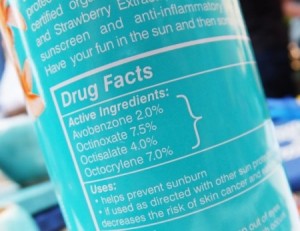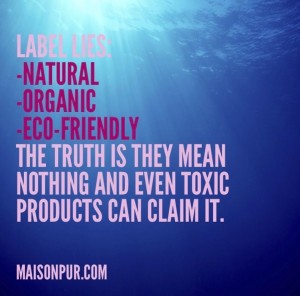
On my last ‘How To Read A Label’ post, I had a formulator weigh in with some things to consider from her perspective. Today we’re going to go over the basics on how you can easily become a label reading pro, and spoiler alert: My best advice is to just DIVE IN! It’s so easy to be intimidated by a lengthy ingredient list or to try to overthink it, but you have to start somewhere and the most important thing is just to start. The best consumer is an informed consumer!
How to get started
Step 1: Grab a product and flip it over to the ingredient list.
Kind of kidding, but it’s almost that easy, I promise.
To keep it simple, choose one product group to start with rather than tackling everything at once. This way you’ll start to see similar ingredients come up across that product category and it will be easier to familiarize yourself with them. Before long you’ll be pretty well versed in that category. For this example, let’s pick sunscreen.
Next, gather any sunscreen you have at home or find one in a store or online that you’re interested in. Then check out the ingredients on the back. This is when the dissecting begins! Maybe you recognize a few ingredients. Maybe they all look like a foreign language. Either way, go through each ingredient. If you don’t know what it is or if it’s safe, look it up!
For our example I picked a sunscreen that claims to be Organic and Eco-luxe on the label:
Coola Eco-Lux Body SPF 30 Organic Sunscreen Spray
We see the active ingredients are 4 chemical sunscreens:
Avobenzone: Can cause skin, eye, and respiratory irritations, may interfere with the function of human sperm
Octinoxate: Rapidly absorbs into skin and is found in urine, blood and breast milk. Can cause endocrine disruption, reproductive and developmental toxicity, organ system toxicity
Octisalate: May interfere with the function of human sperm cells
Octocrylene: Also may interfere with the function of human sperm, May cause long lasting harmful effects to aquatic life
Oops! Not very eco-luxe or organic. At this point, there’s no need to check the inactive ingredients since this is already a no, but in case you wondered what they are, see below. Looks like they included some organic things. Great news for them, since now they can put ORGANIC on the label!
Alcohol (ORGANIC), Algae Extract (ORGANIC), Aloe Barbadensis Leaf Juice (ORGANIC), Cucumis Sativus (ORGANIC Cucumber) Fruit Extract, Fragaria Vesca (ORGANIC Strawberry) Fruit Extract, Glycerin, Methyl Dihydroabietate, Rubus Idaeus (ORGANIC Red Raspberry) Seed Oil
And that’s how BS labels are made, people. But we’re smarter than that. Double checking ingredients isn’t hard and I linked to all of my ingredient info sources above. Honestly, there’s more on each of those, but I just grabbed the top shelf items that come from the most prevalent studies, which was enough to show us their true colors.
There are some great resources out there for researching ingredients, which I’ll share my favorites of. Beware, a few other sites out there can be flawed. They share either incomplete safety data or rate something as low danger when it simply hasn’t been studied (no studies = nothing dangerous has been discovered.. yet). Some even pimp out their “seal” as a mark of safety, but one look at the ingredient list will tell you that seal has more to do with money than with helping consumers find safe products.
Resources
For researching ingredients here are some of my favorite sites:
Step 2: If you spot an ingredient you’re not familiar with, look it up!
Chemical Of The Day– Written by a smart woman formulator, with a strong chemistry background, this site really pulls together existing data on ingredients to give a full and seemingly accurate picture of how safe it is.
Pubmed– Admittedly, not for the faint of heart! This is a huge database of studies that have been done on various chemicals and compounds. If you’re not used to reading through actual studies, it can seem like a lot, but for those who want to go right to the horse’s mouth, this is it.
Campaign For Safe Cosmetics– This is a consumer advocacy group that has a nice ingredient database to search through. It’s much more palatable for beginners than Pubmed, but I like to double check my facts when I reference them, to be sure their sources are correct.
For beginners that want an app just to point you in the right direction while shopping, I prefer Think Dirty. You can scan products, see product ratings and look up ingredients. But I would encourage you to also learn more about individual ingredients as you go though!
Also, don’t be scared to google an ingredient. I’ve found some really good info and studies on ingredients, but of course, be sure the information is legit. There is a lot of misinformation out there. Look for consistency and actual studies to back up the information.
Label Lies
Step 3: Ignore claims made on the label, the truth is always in the ingredient list.
Just like our Coola poser above, brands know that people want natural and eco-friendly products, so things like green-washing and misleading labeling can come into play.
One corn derived ingredient and suddenly they are “Natural” or throw in a couple of organic ingredients so you can slap “Made with Organic Ingredients” on the front. Never mind the other 20 garbage ingredients listed on the back.
Most brands that yell from the rooftops that they’re “Paraben Free!” or “Sulfate Free!”, are trying to distract you from the ingredients they DO have. Anytime you see “made with” or “made without” or “free from” claims, You need to take a good look at the ingredient list. It’s usually a pretty accurate warning sign.
Give me your questions in the comments. I want to equip you with everything you need to be an expert label reader. Be on the lookout this year as I pull some specific ingredients to talk about here and on social media. Happy label reading!








